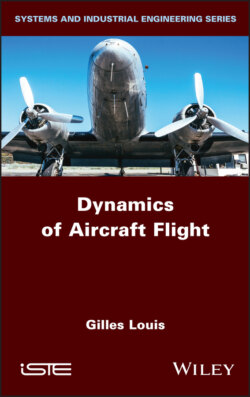Dynamics of Aircraft Flight

Реклама. ООО «ЛитРес», ИНН: 7719571260.
Оглавление
Gilles Louis. Dynamics of Aircraft Flight
Contents
List of Illustrations
Guide
Pages
Dynamics of Aircraft Flight
Foreword
Introduction
I.1. Definition of axes
I.1.1. Roll axis
I.1.2. Yaw axis
I.1.3. Pitch axis
1. Use of Aerodynamic Forces to Control the Trajectory of an Aircraft
1.1. Definitions
1.1.1. Lift
1.1.2.Drag
1.1.3.Equilibrium in horizontal flight
1.1.4.Aerodynamic moments
1.1.5.Center of gravity
1.1.6.Aerodynamic center
1.1.7.Center of thrust
1.1.8.Centering and stability
1.1.9.Lateral stability
1.1.10.Turn and roll
1.1.11.Load factor
1.2. Pitch control
1.3. Yaw control
1.4. Roll control
1.5. The Mach: subsonic, transonic and supersonic speeds
2. Aerodynamic Forces and Moments and their Derivatives
2.1. Definitions
2.2. Aerodynamic forces. 2.2.1.Drag expression
2.2.2.Expression of lateral lift
2.2.3.Expression of lift
2.3. Aerodynamic moments
2.4. Major aerodynamic derivatives
3. Wind Tunnel. 3.1. Description of wind tunnel tests
3.2. Stall
3.3. Calculation of the maximum stress applied to an aircraft wing in a wind tunnel. 3.3.1.Definition of the drag coefficient from the flow tables
3.3.2.Calculation of the maximum stress applied to an aircraft wing in a wind tunnel
4. Trihedron. 4.1. Writing convention
4.2. Definitions of trihedrons. 4.2.1.Definition of a trihedron or frame of reference
4.2.2.Galilean trihedron
4.2.3.Absolute trihedron
4.2.4.Local geographic trihedron
4.2.5.Terrestrial trihedron
4.2.6.Aircraft trihedron
4.2.7.Aircraft aerodynamic speed trihedron (G, Xvae, Yvae, Zvae)
4.2.8.Balance trihedron
4.3. Change of reference
4.4. Relation between trihedra. 4.4.1. Aircraft trihedron (G, X1, Y1, Z1) with respect to the reference trihedron (G, X0, Y0, Z0)
4.4.2. Aerodynamic trihedron of the aircraft (G, Xva, Yva, Zva) with respect to the aircraft trihedron (G, Xe, Ye, Ze)
4.5. Relative positions of the various trihedra. 4.5.1.Position of the aircraft trihedron with respect to the local geographical trihedron
4.5.2.Position of the aerodynamic trihedron with respect to the terrestrial trihedron
4.5.3.Position of the aircraft trihedron in relation to the aerodynamic speed trihedron
4.5.4.Position of the aircraft trihedron in relation to the balance trihedron
4.5.5.Position of the terrestrial trihedron in relation to the local geographic trihedron
5. Movement of a Solid. 5.1. Rotation of a solid around a fixed point
5.2. Kinematics of a solid
5.3. Reference framework. 5.3.1. Absolute reference
5.3.2.Relative reference
5.3.3.Drive movement
5.3.4.Goal
5.3.5.Change of reference framework
5.3.5.1. The movement of (R1) with respect to (R)
5.3.5.2. Derivation composed of a vector
5.3.5.3. Velocity vector of a point with respect to (R) and to (R1)
5.3.5.4. Acceleration vector of a point with respect to (R) and to (R1)
5.3.6.Change of reference: conclusion and summary
5.4. Components of the instantaneous velocity vector of the aircraft reference (O, ie, je, ke)E with respect to the local geographic reference (O, ilgt, jlgt, klgt)LGT in the aircraft reference
5.5. Equations of accelerations and forces in the aircraft frame(O, ie, je, ke)E
5.6. Determination of load factors in the aircraft reference (O, ie, je, ke)E
5.7. Case where the speeds and accelerations are provided at a point other than G
5.8. Coordinates of the aerodynamic speed in aircraft axes
5.9. Equations of moments in the aircraft frame (O, ie, je, ke)E
5.10. Forces and moments applied to the aircraft. 5.10.1.Force of gravity
5.10.2.Forces and moments of propulsion
5.10.3.Aerodynamic forces and moments
5.10.4.Forces and inertia torques
6. Aircraft Characteristics. 6.1. Aerodynamics problems posed by aircraft
6.1.1.Drag
6.1.2.Lift
6.1.3.Reynolds number
6.1.4.Flow velocity
6.1.5.Stability of an aircraft
6.1.6.Resistance of structures
6.1.7.Sizing of an aircraft
6.2. Load factor. 6.2.1.Definition of the load factor
6.2.2.Definition of the load factor requirements
7. Aircraft Simulation Model
7.1. Simulation model of the atmosphere
7.2. Propulsive coefficients
7.3. Mass coefficients
7.4. Aerodynamic coefficients
7.5. Equations of motion
7.6. Introduction of wind
8. Processing of Trajectography Information
8.1. Telemeasured parameters
8.2. Smoothing, first derivation and second derivation
8.3. Performance calculation. 8.3.1.Change of coordinates to move from the trihedron (O, Xc, Yc, Zc) to the trihedron (O, X0, Y0, Z0)
8.3.2.Aircraft speed relative to the ground
8.3.3.Aerodynamic speed and Mach number
8.4. Aerodynamic route and slope
8.5. Determination of the angle Ψ
8.6. Load factors in the aerodynamic trihedron (O, Xa,Yaf, Zr)
8.7. Processing of data from the inertial unit (in the aircraft frame)
8.7.1.Load factor conversion
8.7.2.Calculation of accelerations at the center of gravity
8.7.3.Speed conversion
8.7.4.Calculation of Ψ
8.7.5.Recomposition of the trajectory
8.8. Determination of some aerodynamic parameters. 8.8.1.Determination of the incidence α and sideslip β
8.8.2.Determination of Ψac. 8.8.2.1.Passage of the trihedron (O, Xa, Ya, Za) to the trihedron (O, Xaf, Yaf, Zaf)
8.8.2.2. Reduction of the equation
8.8.3.Determination of θ
8.9. Determination of load factors (nx1, ny1, nz1) in the aircraft trihedron
8.10. Determination of CY and Cz
8.11. Determination of the total incidence
8.12. Determination of the longitudinal attitude compared to the local horizontal plane
8.13. Determination of drag coefficients
8.14. Determination of the pushing force
9. Quaternion Methods. 9.1. Goal
9.2. Reminder of the axis change formulas using Euler angles
9.3. Olinde-Rodrigues’s formulas: definition of quaternions
Glossary
List of Abbreviations
References
Index. A, C
D, F, I
L, M, N
R, S, T
WILEY END USER LICENSE AGREEMENT
Отрывок из книги
Series Editor
.....
We must learn from the consequences of these disasters in order to prevent them from happening again, and engineers have a major role to play, in the sense that they are the guarantors of the safety and reliability of manufactured aircraft and must do everything possible to manage risks in order to minimize the occurrence of such disasters.
NOTE.– The units used in this book are those of the international metric system.
.....